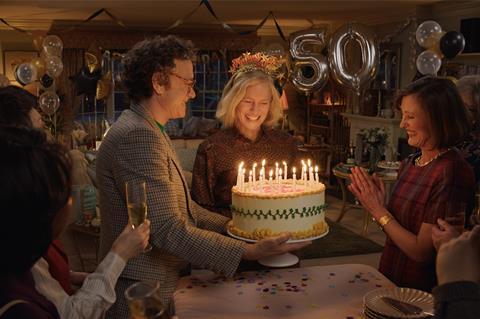Tom Hanks and Robin Wright headline Robert Zemeckis’s ambitious study of lives across time

Dir: Robert Zemeckis. US. 2024. 104mins
Here is set in one location — a piece of land in Pennsylvania — and seen through the perspective of a fixed camera over the course of more than 100 years. The relentless passage of time and the regrets we carry with us are the emotional cornerstones for this formally daring story, which is weighed down by the worst tendences of its director, Robert Zemezkis.
Never fully escapes the staginess of the formal conceit
Tom Hanks and Robin Wright, reuniting with Zemeckis for the first time since Forrest Gump, play the film’s principal characters, a married couple in the second half of the 20th century, although the action jumps back and forth across time, from the age of dinosaurs to the Revolutionary War to the present, showing snippets of other lives. Although there are plenty of lyrical moments, Zemeckis’ lack of restraint and some questionable narrative choices undo what should be a moving affair.
Opening on November 1 in the US (through Sony) before arriving in the UK in January, Here may appeal to adult viewers who have proved less willing to return to theatres since the pandemic. Zemeckis’ last hit was 2012’s modestly-budgeted Flight ($162 million worldwide), although Hanks remains a reliable box-office presence, as evidenced by the $113 million brought in by 2022’s A Man Called Otto. Still, there’s a lack of buzz around Here that suggests only limited theatrical returns.
Based on Richard McGuire’s graphic novel, Here quickly orients the audience to the fact that, in unbroken static shots, we will be watching the same location over generations. At first, there are scenes of dinosaurs or Indigenous peoples, but eventually the film cuts to the last century, focusing on a house that was built in 1907 and will be occupied by several different sets of characters. The most important are Richard (Hanks) and Margaret (Wright), who get married in the early 1960s when they’re in their late teens, a decision prompted by the imminent birth of their daughter. Living with Richard’s parents Al (Paul Bettany) and Rose (Kelly Reilly), they experience the usual ups and downs of domesticity, but their travails are juxtaposed with glimpses from the past and the future — including a married couple (Nicholas Pinnock, Nikki Amuka-Bird) who move in after Richard and Margaret leave.
The graphic novel introduced the clever notion of seeing one location through multiple time perspectives, with images from different eras superimposed upon each other. Zemeckis adopts the same technique, creating boxes inside the frame that show a separate image, which will become part of the next scene, set in a different time period. Inside the house, the camera is always pointing at the living room. (In earlier eras, the camera is positioned in exactly the same place, although these are exterior shots of, say, Native Americans going about their daily routines.)
Not surprisingly, Here has the feel of a stage production, with the actors moving around the space in permanent master shots. Intriguingly, that static shooting style creates the sensation that we are dispassionate, omniscient observers studying the characters. Whether in the Richard and Margaret narrative or the handful of other timelines, Zemeckis keys in on thematic similarities: the cycles of birth and death repeat across the eras, just as the optimism of youth consistently gives way to the disappointment of middle age. At its best, Here does not force these connections but, rather, leaves the viewer to note life’s inescapable predictability.
Working in this more theatrical style, Zemeckis elicits decent performances, although the picture never fully escapes the staginess of the formal conceit. Plus, by jumping between so many different stories, Here only gives us so much information about these people, which inevitably leads to truncated highlights of lives that cover all the familiar dramatic beats. Such simplistic narratives are especially troublesome when Zemeckis ill-advisedly keeps returning to the Indigenous storyline, which comes across as painfully patronising. (The problem also rears its head during one awkwardly staged sequence with Pinnock and Amuka-Bird, who have a heavy-handed conversation with their son about the dangers of being Black when pulled over by the cops.)
The de-ageing techniques used to make Hanks and Wright appear younger are skillfully executed, and the actors manage to create some achingly tender moments. But Zemeckis, as is often the case, cannot resist overdoing potentially poignant moments with cutesy flourishes or by amplifying Alan Silvestri’s string-laden score. The characters’ lack of definition may help them resonate with audiences, who will project their own fears about mortality, loss and failure onto these somewhat blank individuals. But while Zemeckis taps into something powerful about our desire to make our time here on Earth count, it’s bitterly ironic that what his film most needs is, in fact, more time — so we can understand these people better and give their universal anxieties and dreams more resonance.
Production companies: Miramax, ImageMovers
International sales: Miramax, yzhuang@miramax.com
Producers: Robert Zemeckis, Derek Hogue, Jack Rapke, Bill Block
Screenplay: Eric Roth & Robert Zemeckis, based on the graphic novel by Richard McGuire
Cinematography: Don Burgess
Production design: Ashley Lamont
Editing: Jesse Goldsmith
Music: Alan Silvestri
Main cast: Tom Hanks, Robin Wright, Paul Bettany, Kelly Reilly























No comments yet